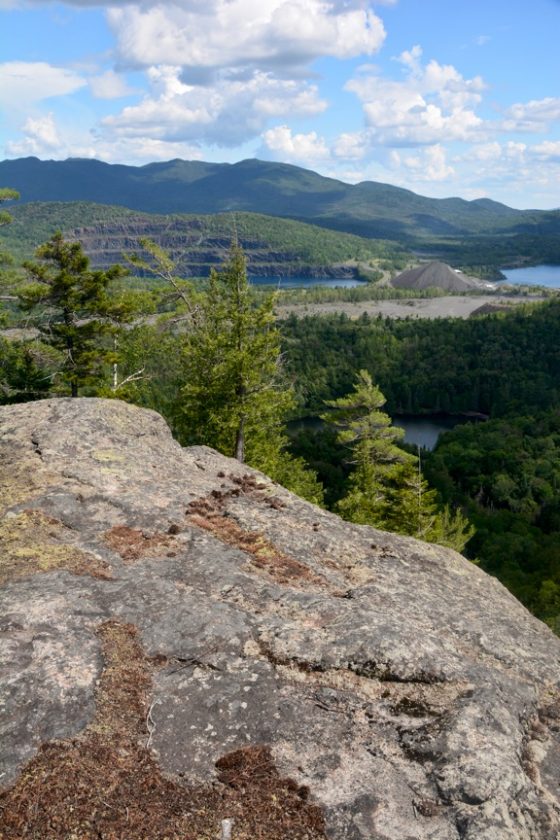SWIMMING THROUGH TREES: Be prepared for your Adirondack bushwhacking adventures

Sneaking a peek of scenery during a bushwhacking trip (Provided photo — Spencer Morrissey)
I have been exploring the Adirondack backwoods for decades and much of that time has been spent off-trail, through the forest, thick and thin, bushwhacking.
I originally took on the formidable task of bushwhacking the 46 High Peaks, and now I have advanced that horizon into a list of 2,500 (currently at 1,530) named and notable peaks, spanning all corners of the Blue Line, most without trails.
I mention this only because I couldn’t have done this without first learning about bushwhacking, by starting small and learning as I go and from others with much more experience. AND the rewards have been plentiful and the friends made along the way; Irreplaceable.
Bushwhacking should not be taken lightly, and should not be taken on by jumping in with both feet.
However, you may already have more experience than you think. Think of it this way, you may have been hiking for years, and it really isn’t all that different. The only other factor is the lack of a defined route, per se. All destinations have a defined route, you just need to discover it.
For those of you just getting into it I recommend starting small to get used to your map and compass. A GPS is not a replacement for good map and compass skills, but you will find a GPS to be a bushwhacker’s best friend. Look into taking an orienteering course and start small, practice where you know you won’t get lost just to test yourself and your gear. Then as your comfort level starts to build, branch out a bit. I could drabble on and on about GPSs, but it is best to do some research before diving in. I recommend the 60 series by Garmin. There are several models now: 60, 62, 64, 66, and even a 68, and each one of those have different features. Navigation is essential to a fun and safe time exploring between contour lines so don’t skimp on the learning.
Bushwhacking has become a much more interesting and admired past-time and quite honestly is drawing more and more people in on the fun. A few popular ventures include the Adirondack 100 Highest, the abandoned trails of old fire tower peaks, and the Adirondack 3,000-footers, where a large majority of the peaks are truly trailless, not to mention countless peaks and ponds with outstanding features that will draw the eye in awe. With that being said, don’t let the pressures of trying something new and exciting glaze over common sense. Do your homework, ask questions, be prepared, have a game plan, an emergency plan, proper gear, and most of all tell someone where you are going. I cannot stress that enough. Find a hiking partner that loves to do it as well, it’s more fun to share in an adventure and safer by far.
—
Dangers of bushwhacking
Bushwhacking also has inherent dangers not seen on most hikes where trails are involved. Some of these include, but are not limited to:
¯ Higher risk of getting lost
¯ Thick undergrowth making travel more difficult
¯ Blow-down or dead-fall blocking travel and requiring you to reroute your course, climb over, or crawl under
¯ Injured body parts including: twisted ankles, hyper extended joints, eye injuries, broken bones, etc.
¯ Confrontation with hunters, not bad ones, just ones where you should consider brighter clothing
¯ Extended time for search and rescue personnel to find you if something goes wrong
¯ No way-finding tools like signs and trail disks
¯ Deep unconsolidated snow
¯ Natural features you may need to navigate around, over, or through
—
Benefits of bushwhacking
Bushwhacking also offers great potential that surely outweighs any of the bad. When exploring off trail you have the chance of:
¯ Wildlife experiences that you don’t get on large crowded trails
¯ Personal space and solitude
¯ Unique and rarely experienced views
¯ Hidden treasures await the explorer–abandoned logging camps, waterfalls, caves, rock formations, an antler shed, wetland area with a rookery, rock slides, cold water springs, and so much more.
—
Gear for bushwhacking
Gear associated with bushwhacking is not all that dissimilar to that of any day hike or overnight excursion that you might partake in on trails.
First you have the basics for your typical daypack:
¯ Food
¯ Water, 1 liter for every two hours
¯ Rain jacket, that can also be used as a wind barrier
¯ And, of course you should always have your Emergency Kit (just in case you should have to spend the night in the woods) which might include:
¯ Matches
¯ Emergency blanket
¯ Fire Starter
¯ Whistle
¯ Dry Socks
¯ Dry Shirt
¯ Two Grocery Bags or two large food storage bags — just in case your boots get wet to use as liners between socks and boots
¯ First Aid Kit
¯ Water Filter
¯ Map and compass – and know how to use it
¯ Camera, optional
¯ Sunscreen, optional
¯ Bug repellent, optional
—
Extra stuff for bushwhacking
¯ GPS — Optional only if you have an area map and compass (you should always have a map and compass — even if you have a GPS!)
¯ Eye protection
¯ Gloves — to protect hands from branches and rock scrambling
¯ Sturdy boots, over the ankle — this should not be optional. Low hiking boots and trail running shoes have their place, just not when bushwhacking
¯ Long sleeved pants and shirts, this will protect you from scratches through thicker terrain, blow down and berry bushes
¯ Extra food, bushwhacking is much more demanding and requires more energy output than trail hiking





